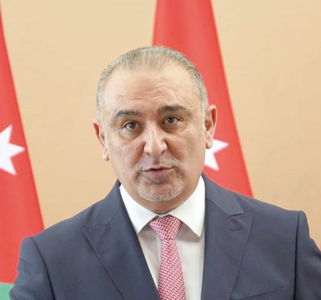You are here
Shraideh details priorities of Public Sector Modernisation roadmap for 2023
By JT - Feb 19,2023 - Last updated at Feb 20,2023

Nasser Shraideh
AMMAN — The government has set 51 priorities for this year based on the recommendations from the national dialogue conducted by the Economic and Social Council, announced Deputy Prime Minister for Economic Affairs and Minister of State for Public Sector Modernisation Nasser Shraideh on Sunday.
The priorities, all of which fall within the executive programme for public sector modernisation roadmap, have been allotted JD45 million from this year's budget for implementation.
The public sector modernisation roadmap aims to improve the quality of services provided to citizens and achieve an effective public sector, the minister said in a statement.
The roadmap includes three main pillars: the services pillar, which encompasses government services, procedures and digitalisation; the institutional pillar, which includes the organisational structure, governance, policy and decision making, human resources and institutional culture; and the legislative pillar.
Each pillar has its own set of priorities, Shraideh said, noting that under the government services component, a set of amendments will be introduced to the legislative and regulatory system for public administration in order to support service governance and monitor performance levels.
This measure is aimed at improving the quality of services through the adoption of a system for developing government services, which will give rise to a guide for managing the services provided, including appropriate service standards in terms of time, quality and other criteria, he said.
There will be an integrated mechanism for measuring the level of service performance, including a review of the mechanisms via the "We Serve You" and "Evaluate Your Experience" platforms, and also by monitoring citizens' opinions on social media.
This will ensure that stakeholders have comprehensive feedback to develop the efficiency and effectiveness of government services, he said, highlighting that several government service centres will be established this year.
The minister also noted that the government aims to digitalise 40 per cent of its services in line with the digital transformation strategy. In this endeavour, the government plans to activate two million digital IDs and create a unified national registry for e-services that links government institutions to provide integrated services to citizens.
The minister also stated that the organisational and governance component will include the administrative, technical and legal reviews to establish the Ministry of Education and Human Resources Development, which will merge the ministries of Education and Higher Education. Similarly, the Ministry of Infrastructure Services will be created from a merger of the ministries of Public Works and Transport, the establishment of which will also require administrative, technical and legal reviews.
Furthermore, the General Statistics Department will be transformed into an interactive national statistics centre to collect, analyse and disseminate data, he said, adding that the Investment Ministry will see restructuring, and its services will be digitised in line with the new Investment Environment Law.
The Service and Public Administration Authority will be established as the successor to the Civil Service Bureau, with its responsibilities expanded to include organisational development processes and human resource management in the public sector. In addition, the Jordan Enterprise Development Corporation (JEDCO) will be restructured to become an umbrella organisation for SMEs and the entrepreneurship sector.
Shraideh noted that all initiatives outlined in the organisational and governance component were supported in the national dialogue conducted by the Economic and Social Council, except for the abolition of the Ministry of Labour. Therefore, the government will restructure the Ministry of Labour and develop its capabilities, making its inclusion as a later priority after concept studies are completed, he said.
This year, the government will also prioritise the restructuring of independent institutions and bodies, he said.
Per the Human Resources component, the government will launch a training programme to enhance the capabilities of public sector employees in public administration, in addition to developing an advanced specialisation scholarship programme, launching additional programmes to qualify government leaders and develop digital skills to support the digital transformation process, he said.
As a part of this component, a human resources strategy that focuses on global trends and practices in the field of human resources management will be launched, the minister added.
Shraideh explained that the organisational culture component will include designing a programme that focuses on change management, empowerment and accountability.
The legislative component includes priorities such as preparing frameworks to develop institutions’ organisational structures while maintaining their legislative and administrative stability and avoiding constant change.
The priorities set by the government in the legislative axis are intended to implement initiatives included in each of the three main components of the roadmap, as approved by the government, he said.
He also announced that the executive programme’s priorities for 2023 include the preparation of an integrated map of donors. This map will facilitate the distribution of ongoing projects and identify the progress made in proposed projects based on consultations and joint agreements.
The map is intended to ensure integration and coordination in the management and implementation of funded programmes, as well as optimising use of available resources and providing a timeframe for implementation, he said.
The Public Sector Modernisation programme has published the priority document on the programme’s website.
Related Articles
AMMAN — His Majesty King Abdullah on Tuesday was briefed on progress in the implementation of the public sector modernisation roadmap, durin
AMMAN — Deputy Prime Minister for Economic Affairs and Minister of State for Public Sector Modernisation Nasser Shraideh on Saturday a
AMMAN — His Majesty King Abdullah on Sunday was briefed on the government’s priorities to implement public sector modernisation.During a mee
















